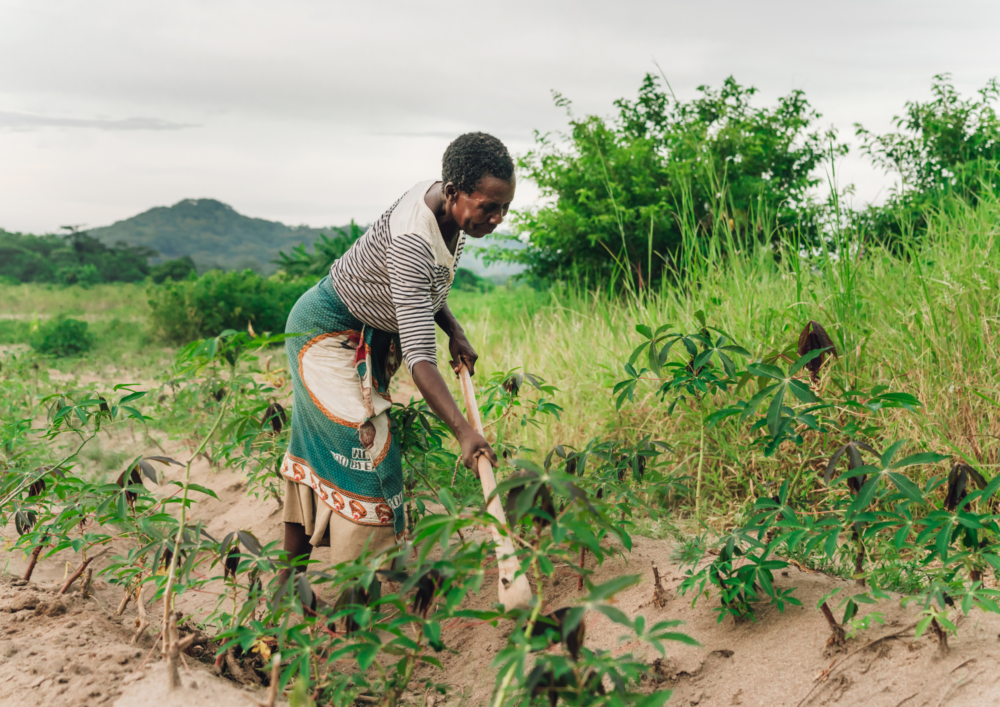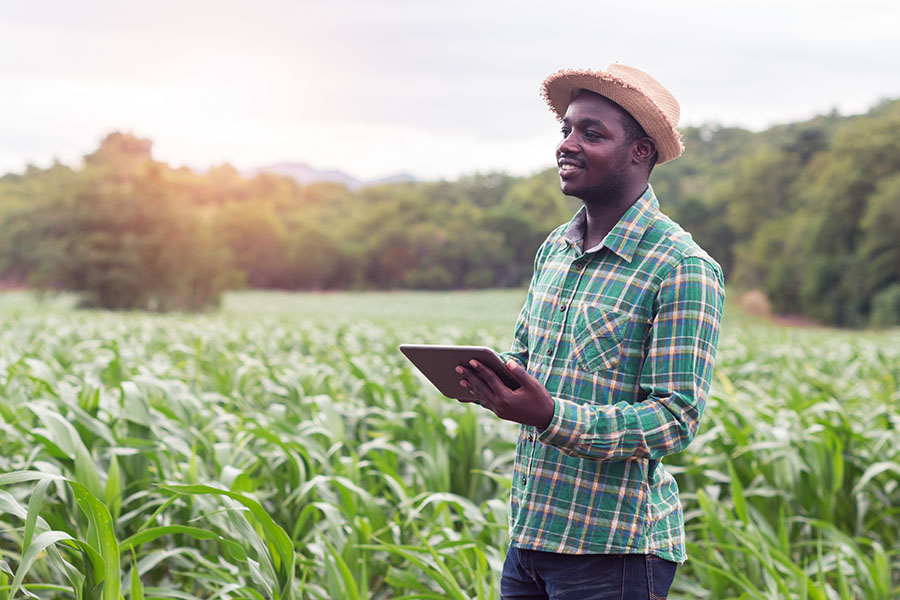Increasing Agroforestry Innovation and Collaboration between the UK and Africa

Agroforestry offers an exciting opportunity to help feed growing populations whilst tackling desertification and biodiversity loss. Interest in agroforestry is growing in both the UK and Africa. Sharing ideas and developing new innovations could help increase the success and adoption of agroforestry globally.
Innovate UK KTN as part of AgriFood Africa Connect is exploring how partners in the UK and Africa can collaborate and innovate to enhance the success and adoption of agroforestry in Africa.
If you are an innovator or stakeholder in agroforestry in the UK or Africa, read on to better understand the current state of agroforestry, and to see how your technology could support in solving challenges.
If you’re interested in agroforestry in the UK or Africa, get in touch with Chris Till.
What is agroforestry?
Agroforestry is the integration of trees and shrubs into agricultural land. It offers many benefits including sequestering carbon dioxide, enhancing biodiversity, improving degraded soils and decreasing soil erosion, while helping feed growing populations. Agroforestry can be an effective mitigation and adaptation pathway to help farmers globally become more climate-resilient and generate new income streams.
Agroforestry can take the form of agrisilvicultural systems,where crops are intercropped with trees, agri-pastoral systems, where trees are grown on pasture, and agrosilvopastoral systems, which are a combination of the two.
Current status of agroforestry in Africa
Close to a fifth of the world’s forests can be found on the African continent. Worryingly, every year 3 million hectares of this important landscape are lost. 65% of Africa’s productive land is degraded, and 45% of the continent’s land area suffers from desertification. Current estimates show that up to 30% of sub-Saharan Africa’s population is food insecure.
Agroforestry has the potential to stabilise soil, buffer against drought stress and enhance soil fertility allowing crop yields to increase. Nutritional diversity can be increased by cropping fruit and nut trees alongside more commonly grown cereals. Agroforestry can support in diversifying the income of farmers through lumber products, fruits and nuts, natural gums and resins, and carbon credits. In these ways, agroforestry increases food security, income and climatic resilience for rural smallholders.
Additional benefits are seen in silvopastoral systems where trees are planted into grazing land. With heat stress being responsible for a 0.35L reduction in daily milk per cow in semi-arid regions of South Africa, trees provide much needed shade for grazing animals, as well as a more diverse diet and extension of the grazing season.
Significant efforts are being made to increase tree cover in sub-Saharan Africa, with a 700,000 ha increase in tree cover due to agroforestry, woodlot and timber plantation efforts between 2011-2019.
Challenges for agroforestry in Africa
Poverty and economic hardship are significant limitations to the uptake of agroforestry in Africa. This is being exacerbated by more frequent, intense and unpredictable weather due to the climate crisis. Additionally, growing human populations are increasing food and nutritional insecurity, resulting in environmental degradation and deforestation due to increased pressure on limited resources. Such factors mean agroforestry, despite its potential, is low priority.
Agroforestry requires a variety of R&D and innovations, as well as support services, such as advice on specific practices that work in each farm context, including weather, soil type and farming practices, as well as technical assistance to ensure success. Barriers to uptake of agroforestry in Africa include:
- Access to skills and technical knowledge.
- Complex land property rights and tenure insecurity.
- Support for capital & financing.
- Illegal exploitation of trees.
- Access to markets.
- Availability of high-quality germplasm and germination/survivability issues.
- Desertification and poor quality soils.
- Lack of infrastructure and mechanisation.
- Lag time between planting and harvesting.
Agroforestry In the UK
According to the Woodland Trust, 3% of the UK farmed area practices agroforestry, yet 72% of UK land is farmed. The UK government’s 25-Year Environment Plan and Clean Growth Strategy includes agroforestry as a key element in a number of its ambitious goals and agroforestry is now part of the Basic Payment Scheme, the biggest of the rural grants and payments to help farmers in the UK. 13.3 thousand hectares of new woodland were created in the UK in 2020-21 and the area of farm woodland has increased to 1.1 million hectares from 0.8 ha in the ten years since 2011.
The Committee on Climate Change estimates that agroforestry could result in carbon emissions savings of 5.9 MtCO2e per year by 2050 in the UK. This represents approximately 13% of the total current emissions from the agriculture sector. A renewed push for agroforestry to help to meet the government’s climate change goals means there is increasing interest in the UK in agroforestry.
Challenges for agroforestry in the UK
The barriers to agroforestry in the UK are relatively similar to those in Africa. Agroforestry requires farmers and growers to invest in new equipment and to modify current tried and tested agriculture practices. Climate change is increasing the frequency of extreme weather events, including droughts. In southern, central and eastern regions of England in particular, the trend for warmer summer temperatures is reducing soil moisture. This impacts germination and establishment, and reduces tree growth. In addition, the incidence of non-native invasive species, and the severity of tree disease will increase as winters get warmer and pests, and pathogens undergo range expansion from Europe.
Innovation and investment are key to sustainably increasing the uptake of agroforestry in both the UK and Africa. There are many exciting innovations being developed, as well as opportunities for new innovations and further research in these areas:
- Soil improvement
Additives and amendments at the planting stage can be used to help restore soil fertility, improve drainage, decrease soil erosion and reintroduce a thriving community of soil associated microorganisms. Amendments to soil may include the incorporation of lime, biochar, biostimulants or even bio-fertilisers. These amendments increase tree seedling survival during the critical early years and improve plant health. - Physical protection
New trees and shrubs are most vulnerable during their first year but can remain vulnerable to browsing by wildlife for up to ten years after planting. Physical barriers around tree seedlings reduce or eliminate this damage. Biodegradable tree guards provide the best sustainable protection. Other physical interventions can be used to minimise water evaporation from the soil, giving areas of desertification a better chance for plant growth. - Germination improvement
Planting vulnerable tree seeds into nutrient-depleted and degraded soils can significantly reduce germination efficiency. New technologies utilising hydrogels, innovative seed treatments and encrustment technologies can improve germination success of planted tree seeds and enhance seedling survival in land that has undergone desertification. - Decision making and monitoring
Using geospatial approaches leveraging satellite imaging can help make more informed and precise decisions on the suitability of agroforestry sites. Additionally, using geospatial technologies to map tree species to particular sites and account for their vulnerabilities and impact on biodiversity can be more time and cost efficient than physical on-the-ground assessments. Understanding the impact of agroforestry requires monitoring tree growth, the impacts of environmental change, fire and disease outbreaks, and the impact on biodiversity. Effective monitoring also opens up options for carbon credits as possible novel revenue streams for farmers. - Nursery establishment and technologies
Establishing effective tree nurseries can help improve the production of quality seeds and assist growers in matching the correct germplasm to the appropriate environment. Innovations may include the ability to monitor and track seedling growth to ensure plant health and disease management. Radio Frequency ID (RFID) or Bluetooth Low Energy (BLE) tags can be placed on seedlings for logistical purposes (i.e. getting the correct tree species to the correct location) and to ensure traceability.
Get involved
We are exploring how organisations in the UK and Africa can collaborate and innovate to improve the success and adoption of agroforestry in Africa.
We’d like to hear from you if you are:
- An organisation working on agroforestry projects in Africa or the UK
- An innovator who has developed a practice or innovation which will increase the success or adoption of agroforestry
We will be running an event around agroforestry in the UK and Africa and are looking for organisations to get involved.
Get in touch with Chris Till to discuss how we can help fast track your innovation and how you can get involved in the event.
Related Opportunities
GCRF AgriFood Africa Innovation Awards Round 3
Opens: 25/07/2022 Closes: 30/08/2022
The GCRF Agrifood Africa Innovation Awards Round 3 is a £1.3 million funding scheme for collaborative UK/Africa projects to address African AgriFood challenges. Successful applicants will receive a grant of either £20,000 or £30,000 to support their collaborative UK/Africa AgriFood research and i
More Information
Farming Innovation Programme - feasibility round 2
Opens: 31/08/2022 Closes: 12/10/2022
UK registered businesses can apply for a share of £5.5 million for feasibility projects, from the Industry-led R&D Partnerships Fund, a part of the Farming Innovation Programme.
More Information
Farming Innovation Programme small R&D partnership projects round 2
Opens: 31/08/2022 Closes: 02/11/2022
UK registered businesses can apply for a share of up to £11million for Small R&D Partnership Projects from the Industry-led R&D Partnerships Fund, a part of the Farming Innovation Programme.
More Information
Related programmes

AgriFood Africa Connect Map
The AgriFood Africa Connect Map makes it easier for UK and African organisations to collaborate on projects, provides information on the AgriFood sector across Africa, and helps connect innovators to enable collaboration and address key global challenges.

AgriFood Africa Connect
Innovate UK AgriFood Africa Connect brought innovative people and organisations across the UK and Africa together to develop solutions for the sustainable management of AgriFood systems in Africa.

